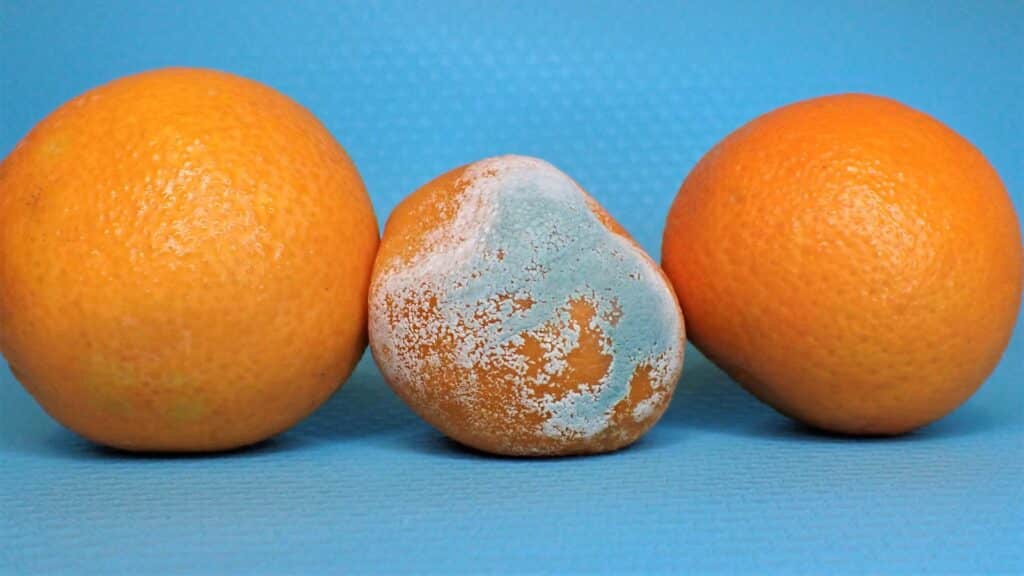We all know mold and have unfortunately dealt with that gross fungus that seems to form on various surfaces and food items. While mold can be harmless, other molds produce what are called “mycotoxins” which are harmful when ingested.
In today’s article we will learn about the potential consequences of eating moldy food and the impact it may have on your health.
How do you know if food is moldy?
Although there are types of tasty mold you can eat, we’re not exactly talking about blue cheese. If you’re unsure about the state of your food, here’s some of our recommendations on how to easily identify moldy foods.
Look out for unusual white spots or discoloration on your food
Black, white, green, or blue spots on your food are likely indicators for mold. Mold can also take the form of larger areas of significant discoloration and can grow on most types of food products – think dairy products, fruit, vegetables, baked goods, and even your leftovers. Make sure you throw away food with any visible signs of mold growth.
There should be a strange or even bad smell from your food
If you smell a musty smell, or if your food just generally smells “off”, it is most likely mold. Always err on the side of caution – if your food smells unusual, throw it out!
The food seems to be flimsy or even squishy
Mold can cause certain foods to change texture. In instances where your food is now mushy, softer than usual, or has a slimy sheen to it, then mold has most likely begun to grow. This could be potentially unsafe to eat and must be thrown away.
What are the symptoms of eating mold?
You’re probably wondering what happens if you accidentally consumed mold without knowing, or eat food that has been contaminated with mold. Ingesting mold can lead to a variety of symptoms and health issues – but the severity of these symptoms vary depending on the type and amount of mold ingested. The sensitivity of the individual’s digestive system will also determine how their body reacts to mold.
Nausea can occur as a prolonged side effect
According to the World Health Organization, eating moldy food may cause nausea. This nausea may not last long, but there is a possibility that this nausea can be persistent and lead to an upset stomach that lasts for hours or even days depending on the level of exposure.
Gastrointestinal issues may arise with eating mold
On top of upset stomach and nausea, other gastrointestinal issues arise with eating mold. These symptoms that may be experienced include: diarrhea, abdominal pain, and bloating, and the severity of these symptoms can be mild to severe.
Mold can sometimes cause a similar reaction to allergies
Individuals with pre-existing respiratory conditions or even weakened immune systems may be susceptible to allergic reactions to mold consumption. These allergic symptoms can include watery eyes, itching, sneezing, coughing, and in bad cases, difficulty breathing.
How to avoid the risk of having moldy food
You’re probably curious about ways to avoid ingesting moldy food. In this case, prevention is key. Here are some tips to minimize your risk.
Keep food in airtight containers
A primary factor in mold growth is buildup of moisture. Storing food in a dry, clean airtight container can help prevent moisture, and prolong the growth of mold.
Do not buy fresh produce in excess
Overbuying food, especially fresh produce (fruits and vegetables), can put you in a position where you’ve bought more food than you can actually consume in the time before the food spoils. As more time passes and the fresh produce just sits, the likelihood of mold growth increases.
Maintain the cleanliness of your kitchen and kitchen appliances
Regularly cleaning your kitchen and other areas prone to moisture, like your sinks and dishwashers, is essential in preventing mold spores from spreading. Make sure to also stay on top of cleaning your countertops, cutting boards, and utensils.
Keep the temperature of your freezer and refrigerator correct
Make sure you maintain the ideal temperatures in your freezer and refrigerator to prevent the growth of mold. The ideal temperature for your refrigerator is 40 degrees F (4 degrees C), and the ideal temperature for a freezer is 0 degrees F (-18 degrees C). Keeping the temperatures at these values helps to control and slow the growth of mold, and extends the shelf life of your food.
For any worries you have about mold, UES is here to calm your nerves!
The bottom line is, if you suspect that you’ve consumed moldy food, or have concerns about food in your kitchen area, please monitor your symptoms closely, and consult your doctor or a healthcare professional for advice. A professional can help provide guidance based on your specific situation and offer medical insight. Consuming moldy can have many various health implications – from mild symptoms to more severe reactions and GI issues. Make sure to be vigilant of the signs of mold, like black mold, and practice proper food safety, storage and hygiene.
UES can help you learn about all things mold. Serving all of Florida, we are your Mold Assessment experts!


